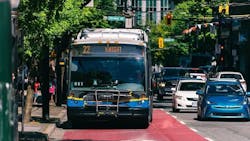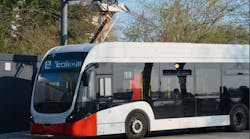TransLink has identified 20 corridors that need increased bus priority investments to mitigate the impacts growing traffic congestion has on bus riders. The plan is part of TransLink’s Bus Priority Vision, which identifies solutions to improve bus efficiency while highlighting the need to make buses more reliable in Metro Vancouver.
“As traffic gets worse throughout Metro Vancouver, our customers spend more time stuck on buses and less time moving,” says TransLink CEO Kevin Quinn. "Bus delays cost us more than C$80 million (US$58.19 million) each year and we are committed to developing new bus priority measures that will mitigate those costs and get our customers where they need to go faster.”
Every weekday, TransLink notes bus riders throughout Metro Vancouver spend more than 28,000 hours stuck in traffic combined. Nearly half (45 percent) of those delays occur on the top 20 corridors despite making up only 15 percent of the transit network.
TransLink notes that while more studies are needed to determine specific improvements, its goal is to work with regional municipalities to explore new bus speed and reliability measures on the 20 identified corridors during the next decade.
The 20 priority corridors were determined by factoring in average bus delays, ridership volumes, existing infrastructure and accounting for different locations throughout Metro Vancouver.
Some examples of bus speed and reliability improvements that TransLink will engage with stakeholders and municipalities on include:
- Dedicated bus lanes
- Approach lanes
- Queue jumps
- Balancing distances between bus stops
- Turn restrictions
- Signal improvements and upgrades
Since 2019, TransLink has invested C$40 million (US$29.1 million) into bus speed and reliability measures, reducing delays up to 35 percent on those corridors.
The next step is to secure funding for TransLink’s 10-Year Access for Everyone Plan, which includes expanded bus speed and reliability measures.



